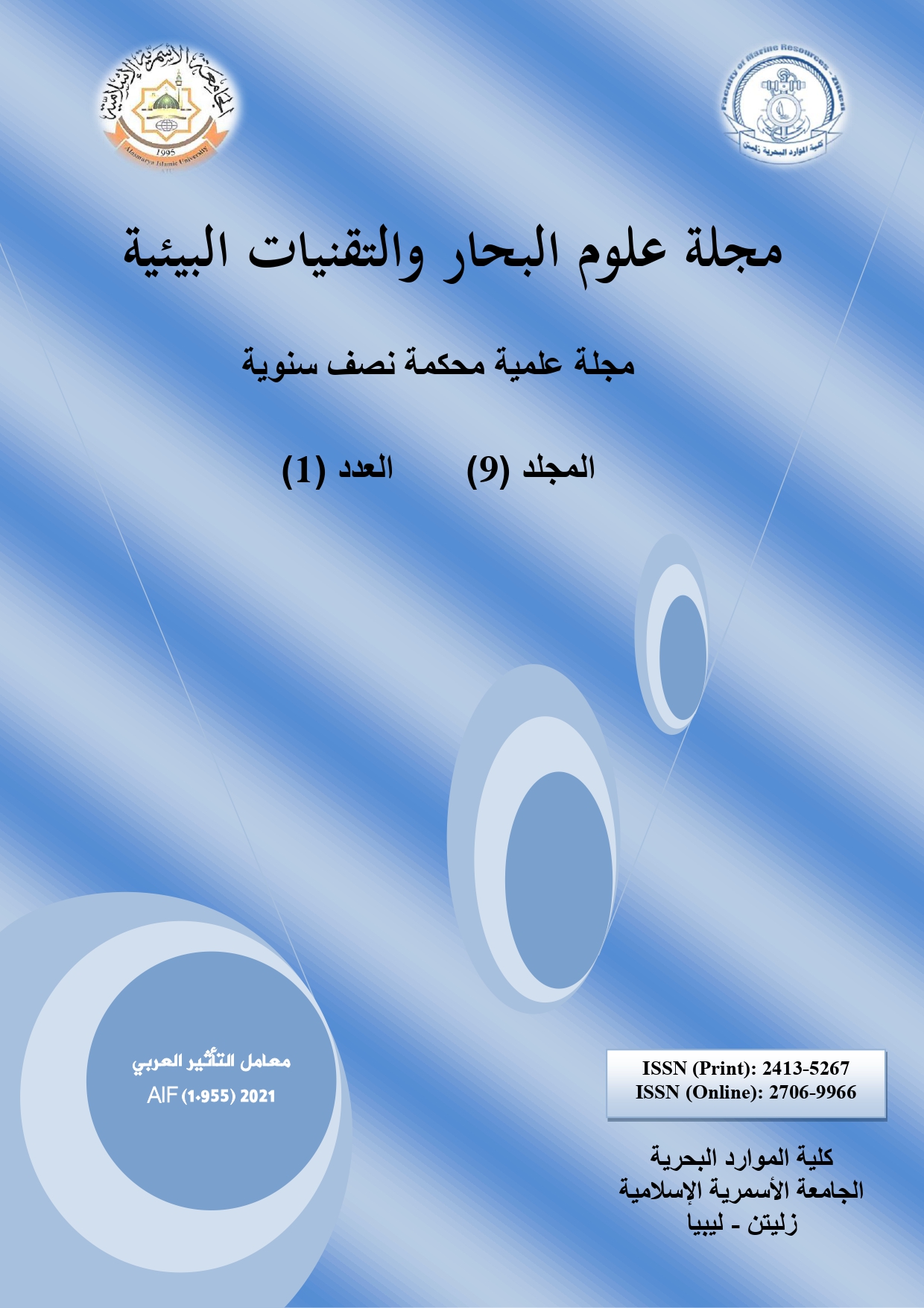تأثير الرش ببعض المحفزات الحيوية التجارية على الاستجابات الفسيولوجية لنبات الباذنجان
DOI:
https://doi.org/10.59743/jmset.v9i1.146الكلمات المفتاحية:
الباذنجان، المحفزات الحيوية، حمض الهيومك، حمض أميني، استجابات فسيولوجيةالملخص
أجريت هذه الدراسة لتحديد تأثير اثنين من المنشطات الحيوية (Humic Power وAmino 24) على النمو ومحتوى المغذيات في نبات الباذنجان (Solanum melongena. L) صنف Master F1 المزروع تحت ظروف الصوبة البلاستيكية، استخدم في التجربة تصميم القطاعات كاملة العشوائية بثلاث مكررات. كما تم استخدام مستويات مختلفة من المنشط الحيوي Humic Power هي (الشاهد، 3 مل/لتر، 5 مل/لتر) كما استخدمت مستويات مختلفة من منشط النمو الحيوي Amino 24 هي (الشاهد، 1 مل/لتر، 2 مل/لتر) رشا على المجموع الخضري كل 15 يومًا طوال فترة الدراسة. سجلت أعلى زيادة في صفات النمو الخضري (ارتفاع النبات، عدد الأوراق لكل نبات، مساحة الورقة، محتوى الكلوروفيل الكلي عند المعاملة (HP.2) من Humic Power مع المعاملة ((AM.2 من منشط النمو الحيوي Amino 24، تليها النباتات المعاملة بـ ((HP.1 مع (AM.2) مقارنة بالنباتات غير المعاملة. من ناحية أخرى، كان هناك تداخل معنوي بين المنشطات الحيوية (Humic Power وAmino 24) لمحتوى العناصر الغذائية في نباتات الباذنجان باستثناء محتوى البوتاسيوم حيث كان الفرق غير معنوي. تم الحصول على أعلى محتوى من النيتروجين والفسفور والبوتاسيوم مع المعاملة HP.2)) والمعاملة AM).2) على التوالي بالمقارنة مع نباتات الشاهد.
التنزيلات
المراجع
Abbas M.M. & Hussain W.S. (2020). Bio stimulants of Pepper and Eggplant by using plants aqueous extract. Plant Cell Biotechnology and Molecular Biology, 21(65&66): 78-82.
Adani F., Genevini P., Zaccheo P., & Zocchi G. (1998). The effect of commercial humic acid on tomato plant growth and mineral nutrition. Journal of Plant Nutrition, 21(3): 561-575. DOI: https://doi.org/10.1080/01904169809365424
Alicja P.O.H.L., Grabowska A., Kalisz A., & Sekara A. (2019). The eggplant yield and fruit composition as affected by genetic factor and biostimulant application. Notulae Botanicae Horti Agrobotanici Cluj-Napoca, 47(3): 929-938. DOI: https://doi.org/10.15835/nbha47311468
Azarpour E., Motamed M.K., Moraditochaee M., & Bozorgi H.R. (2012). Effects of bio, mineral nitrogen fertilizer management, under humic acid foliar spraying on fruit yield and several traits of eggplant (Solanum melongena L.). African Journal of Agricultural Research, 7(7): 1104-1109. DOI: https://doi.org/10.5897/AJAR11.1833
Brown P. & Saa S. (2015). Biostimulants in agriculture. Frontiers in Plant Science, 6: 671. DOI: https://doi.org/10.3389/fpls.2015.00671
Chen Y., Nobili M.D., & Aviad T. (2004). Stimulatory effects of humic substances on plant growth. Soil Organic Matter in Sustainable Agriculture, 103-129. DOI: https://doi.org/10.1201/9780203496374.ch4
Doran I., Akinci C., & Yildirim M. (2003). Effects of delta humate applied with different doses and methods on yield and yield components of Diyarbakir-81 wheat cultivar. In: 5th Field Crops Congress. Diyarbakir, Turkey, Vol. 2: 530-534.
Drobek M., Frąc M., & Cybulska J. (2019). Plant biostimulants: Importance of the quality and yield of horticultural crops and the improvement of plant tolerance to abiotic stress—A review. Agronomy, 9(6): 335. DOI: https://doi.org/10.3390/agronomy9060335
Du Jardin P. (2015). Plant biostimulants: Definition, concept, main categories and regulation. Scientia horticulturae, 196: 3-14. DOI: https://doi.org/10.1016/j.scienta.2015.09.021
Dursun A., Güvenç I., & Turan M. (2002). Effects of different levels of humic acid on seedling growth and macro and micronutrient contents of tomato and eggplant. Acta Agrobotanica, 55(2): 81-88. DOI: https://doi.org/10.5586/aa.2002.046
El-Ghamry A.M., Abd El-Hai K.M., & Ghoneem K.M. (2009). Amino and humic acids promote growth, yield and disease resistance of faba bean cultivated in clayey soil. Aust. J. Basic Appl. Sci, 3(2): 731-739.
El-Nemr M.A., El-Bassiony A.M., Tantawy A.S., & Fawzy Z.F. (2015). Responses of eggplant (Solanum melongena var. esculenta L) plants to different foliar concentrations of some Bio-Stimulators. Middle East Journal of Agriculture Research, 4(4): 860-866.
Ghabbour E.A. & Davies G. (2001). Humic substances: structures, models and functions, Vol. 273. Royal Society of Chemistry. DOI: https://doi.org/10.1039/9781847551085
Hadia E., Slama A., Romdhane L., M'Hamed H.C., Fahej M.A.S., & Radhouane L. (2022). Seed Priming of Bread Wheat Varieties with Growth Regulators and Nutrients Improves Salt Stress Tolerance Particularly for the Local Genotype. Journal of Plant Growth Regulation, 42(1): 304-318. DOI: https://doi.org/10.1007/s00344-021-10548-3
Haghighi M., Saadat S., & Abbey L. (2020). Effect of exogenous amino acids application on growth and nutritional value of cabbage under drought stress. Scientia Horticulturae, 272: 109561. DOI: https://doi.org/10.1016/j.scienta.2020.109561
Hassan H.A., Shaheen M.M., Abeda A.T., & Abdeldaym E.A. (2019). Growth and production of potato plant influenced by bio-stimulants and soilless culture systems. Plant Archives, 20(2): 485504863.
Kowalczyk K., Zielony T., & Gajewski M. (2008). Effect of Aminoplant and Asahi on yield and quality of lettuce grown on rockwool. In: Conf. of biostimulators in modern agriculture, 7-8.
McDonnell R., Holden N.M., Ward S.M., Collins J.F., Farrell E.P., & Hayes M.H.B. (2001). Characteristics of humic substances in heathland and forested peat soils of the Wicklow Mountains. In: Biology and Environment, Proceedings of the Royal Irish Academy, 187-197. Royal Irish Academy.
Michalojc Z. & Buczkowska H. (2008). Content of macroelements in eggplant fruits depending on nitrogen fertilization and plant training method. Journal of Elementology, 13(2).
Russo R.O. & Berlyn G.P. (1991). The use of organic biostimulants to help low input sustainable agriculture. Journal of Sustainable Agriculture, 1(2): 19-42. DOI: https://doi.org/10.1300/J064v01n02_04
Shaheen A.M., Rizk F.A., Habib H.A., & Abd El-Baky M.M.H. (2010). Nitrogen soil dressing and foliar spraying by sugar and amino acids as affected the growth, yield and its quality of onion plant. Journal of American Science, 6(8): 420-427.
Usharani K.V., Roopashree K.M., & Naik D. (2019). Role of soil physical, chemical and biological properties for soil health improvement and sustainable agriculture. Journal of Pharmacognosy and Phytochemistry, 8(5): 1256-1267.
التنزيلات
منشور
إصدار
القسم
الرخصة
الحقوق الفكرية (c) 2023 مجلة علوم البحار والتقنيات البيئية

هذا العمل مرخص بموجب Creative Commons Attribution 4.0 International License.












